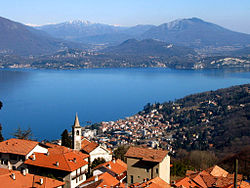Province of Verbano-Cusio-Ossola
| Province of Verbano-Cusio-Ossola | |
|---|---|
| Province | |

Stresa in foreground (Province of Varese across lake)
|
|
 Map highlighting the location of the province of Verbano-Cusio-Ossola in Italy |
|
| Country |
|
| Region | Piedmont |
| Capital(s) | Verbania |
| Comuni | 76 |
| Government | |
| • President | Massimo Nobili |
| Area | |
| • Total | 2,255 km2 (871 sq mi) |
| Population (2006) | |
| • Total | 161,732 |
| • Density | 72/km2 (190/sq mi) |
| Time zone | CET (UTC+1) |
| • Summer (DST) | CEST (UTC+2) |
| Postal code | Verbania: 28921-28925, Other areas: 28811-28897 |
| Telephone prefix | 0163, 0322, 0323, 0324 |
| ISO 3166 code | VB |
| Vehicle registration | VB |
| ISTAT | 103 |
Verbano-Cusio-Ossola (Italian: Provincia del Verbano Cusio Ossola [verˈbaːno ˈkuːzjo ˈɔssola]) is the northernmost province in the Italian region of Piedmont. It was created in 1992 through the fusion of three distinct regions which had previously been part of the Province of Novara. The area flanking the western shore of Verbano (or Lago Maggiore) forms the eastern part of the province; Cusio (or Lago d’Orta) and its environs form the southern part; while the north and east of the province consists of the Ossola, a region of Alpine mountains and valleys. The ISO code for the province is VB.
The province has a total population of some 160,000, distributed over an area of 2,255 square kilometres (871 sq mi), with the biggest population centres being its capital Verbania on the shores of Lago Maggiore, Domodossola the main town of the Ossola, and Omegna at the northern end of Lago d’Orta.
There are 77 comuni in the province.[1] The largest by population are:
In 2003, the Sacred Mountain of Domodossola and the Sacred Mountain of Ghiffa were inserted by UNESCO in the World Heritage List.
Sacro Monte di Domodossola
View of the chapels IX and XI
...
Wikipedia
